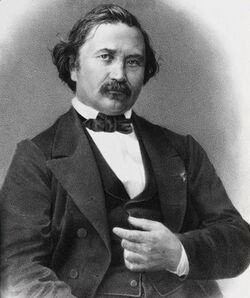Biography:Joseph Bertrand
Joseph Louis François Bertrand | |
|---|---|
 | |
| Born | 11 March 1822 |
| Died | 5 April 1900 (aged 78) Paris, France |
| Scientific career | |
| Fields | Mathematics |
Joseph Louis François Bertrand (French pronunciation: [ʒozɛf lwi fʁɑ̃swa bɛʁtʁɑ̃]; 11 March 1822 – 5 April 1900) was a French mathematician whose work emphasized number theory, differential geometry, probability theory, economics and thermodynamics.[1]
Biography
Joseph Bertrand was the son of physician Alexandre Jacques François Bertrand and the brother of archaeologist Alexandre Bertrand. His father died when Joseph was only nine years old; by that time he had learned a substantial amount of mathematics and could speak Latin fluently. At eleven years old he attended the course of the École Polytechnique as an auditor. From age eleven to seventeen, he obtained two bachelor's degrees, a license and a PhD with a thesis concerning the mathematical theory of electricity, and was admitted to the 1839 entrance examination of the École Polytechnique. Bertrand was a professor at the École Polytechnique and Collège de France, and was a member of the Paris Academy of Sciences of which he was the permanent secretary for twenty-six years.
He conjectured, in 1845, that there is at least one prime number between n and 2n − 2 for every n > 3. Chebyshev proved this conjecture, now termed Bertrand's postulate, in 1850. He was also famous for two paradoxes of probability, known now as Bertrand's Paradox and the Paradox of Bertrand's box. There is another paradox concerning game theory that is named for him, known as the Bertrand Paradox. In 1849, he was the first to define real numbers using what is now termed a Dedekind cut.[2][3]
Bertrand translated into French Carl Friedrich Gauss's work concerning the theory of errors and the method of least squares.
Concerning economics, he reviewed the work on oligopoly theory, specifically the Cournot Competition Model (1838) of French mathematician Antoine Augustin Cournot. His Bertrand Competition Model (1883) argued that Cournot had reached a very misleading conclusion, and he reworked it using prices rather than quantities as the strategic variables, thus showing that the equilibrium price was simply the competitive price.
His book Thermodynamique states in Chapter XII, that thermodynamic entropy and temperature are only defined for reversible processes. He was one of the first people to state this publicly.
In 1858 he was elected a foreign member of the Royal Swedish Academy of Sciences.
Works by Bertrand
- Traité de calcul différentiel et de calcul intégral (Paris : Gauthier-Villars, 1864–1870) (2 volumes treatise on calculus)
- Rapport sur les progrès les plus récents de l'analyse mathématique (Paris: Imprimerie Impériale, 1867) (report on recent progress in mathematical analysis)
- Traité d'arithmétique (L. Hachette, 1849) (arithmetics)
- Thermodynamique (Paris : Gauthier-Villars, 1887)
- Méthode des moindres carrés (Mallet-Bachelier, 1855) (translation of Gauss's work on least squares)
- Leçons sur la théorie mathématique de l'électricité / professées au Collège de France (Paris : Gauthier-Villars et fils, 1890)
- Calcul des probabilités (Paris : Gauthier-Villars et fils, 1889)[4]
- Arago et sa vie scientifique (Paris : J. Hetzel, 1865) (biography of Arago)
- Blaise Pascal (Paris : C. Lévy, 1891) (biography)
- Les fondateurs de l'astronomie moderne: Copernic, Tycho Brahé, Képler, Galilée, Newton (Paris: J. Hetzel, 1865) (biographies)
See also
- Bertrand paradox (probability) – Probability theory paradox
- Finance:Bertrand paradox (economics)
- Bertrand's box paradox – Mathematical paradox
- Bertrand's postulate – Existence of a prime number between any number and its double
- Physics:Bertrand's theorem – Physics theorem
- Bertrand's ballot theorem – Theorem that gives the probability that an election winner will lead the loser throughout the count
- Bertrand–Edgeworth model – Economic Model
- Bertrand curve
- Buckingham π theorem – Theorem in dimensional analysis
Further reading
- Struik, D.J. (1970–1980). "Bertrand, Joseph Louis Francois". Dictionary of Scientific Biography. 2. New York: Charles Scribner's Sons. pp. 87–89. ISBN 978-0-684-10114-9.
References
- ↑ Éloge historique de Joseph Bertrand par Gaston Darboux (1902)
- ↑ Bertrand, Joseph (1849). Trait'e d'Arithmetique. page 203. https://gallica.bnf.fr/ark:/12148/bpt6k77735p/f209.image.r=%22joseph%20bertrand%22. "An incommensurable number can be defined only by indicating how the magnitude it expresses can be formed by means of unity. In what follows, we suppose that this definition consists of indicating which are the commensurable numbers smaller or larger than it ...."
- ↑ Spalt, Detlef (2019). Eine kurze Geschichte der Analysis. Springer. doi:10.1007/978-3-662-57816-2. ISBN 978-3-662-57815-5.
- ↑ Davis, Ellery W. (1891). "Review: Calcul des Probabilités, par J. Bertrand". Bull. Amer. Math. Soc. 1 (1): 16–25. doi:10.1090/s0002-9904-1891-00020-6. https://www.ams.org/journals/bull/1891-01-01/S0002-9904-1891-00020-6/S0002-9904-1891-00020-6.pdf.
External links
- Bertrand, Joseph Louis Francois (1822–1900)
- Joseph Louis François Bertrand (archived 4 April 2004)
- References for Joseph Bertrand (archived 3 March 2016)
- Joseph Louis François Bertrand
- Works by Joseph Bertrand at Project Gutenberg
- Error in Template:Internet Archive author: Joseph Bertrand doesn't exist.
- Author profile in the database zbMATH
 |

